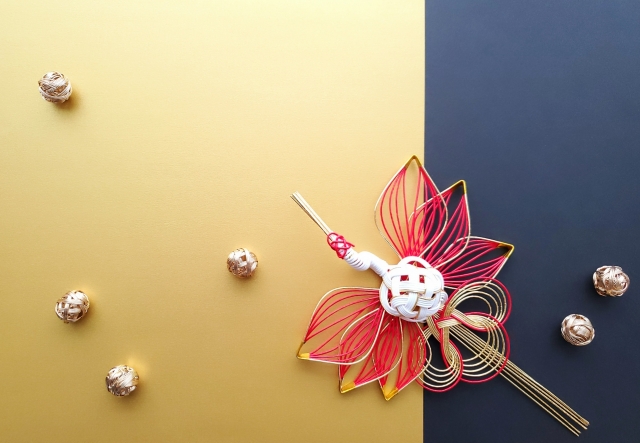日本で一番大切な行事といえば「お正月」ですよね。
そんな日本の正月に興味のある外国人も多く、お正月について聞かれることもあるでしょう。
そんな時、日本のお正月について、英語で説明できるようにしておきたいですね。
今回は7つの項目に分けて、基本的なお正月に関することを英語でシンプルに伝えられるようにまとめました。
ぜひ参考にしてみてください!
もくじ
日本のお正月を英語で説明しよう!【例文付き】
1、日本のお正月に関する基本的なこと
基本的な日本のお正月の説明をしましょう。
新年の意味の英語は固有名詞になるので、“New Year” と、頭文字は大文字で表します。
ただ、そこまで気にされていなく、ネイティブでも小文字で書いていることが見られるので頭の片隅に置いておけば大丈夫でしょう。
基本の語彙
| 新年 | New Year |
| お正月、元旦 | New Year’s Day |
| 大晦日 | New Year’s Eve, The end of the year |
| お正月休み | New Year’s holyday |
New Year’s day is the most important event of the year for Japanese people.
(お正月は日本人にとって1年で最も大事な行事です。)
New Year’s holiday is 3 days from January 1st to January the 3rd.
(お正月休みは1月1日から1月3日の3日間です。)
Many Japanese people usually have a family get together to celebrate the New Year.
(多くの日本人は家族で集まって新年を祝います。)
a family get togeter:家族の集まり
2、大掃除について
年末の大掃除も、正月を迎えるための大切な行事のひとつですよね。
年末に大掃除をするのは日本の独特の風習なので、
英語で説明できるようにしておくと話が盛り上がれそうですね。
We clean up everywhere in our house toward the end of the year.
(私たちは年末にかけて家じゅうを掃除します。)
Year-end cleaning is a Japanese custom before the New Year.
(年末の大掃除は、新年の前の日本の習慣となっています。)
“Year-end cleaning” で 「年末の大掃除」と言えます。
We get rid of the dirt of the year and get ready to welcome the New Year.
(その年の汚れを落として、新年を迎える準備をします。)
welcome the New Year:新年を迎える
他にも、”ring in the New Year” という表現があり、「新年を迎える、祝う」や「年を越す」の意味となります。
新年に教会で鐘が鳴らされることが由来と言われています。
3、年越しそばについて
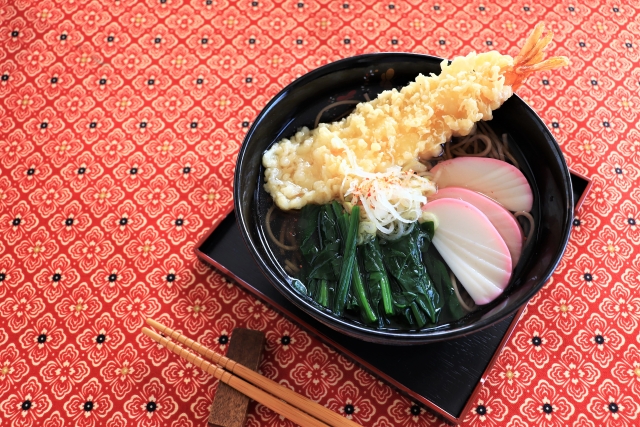
日本では年末にお蕎麦を食べることが古くからの習慣ですね。
他の国では、年末にどんな食べ物を食べるのかを聞いてみても話が盛り上がりそうですよね。
まずは日本の「年越しそば」について話せるようにしておきましょう。
Traditionally, Japanese people eat buckwheat noodles at night on the last day of the year.
(伝統で、日本人は大晦日の夜に蕎麦を食べます。)
The noodles are called “Toshikoshi-soba” which means “year crossing noodles”.
(それを”年越しそば” と呼びます。”year crossing noodles“ の意味です。)
People eat them in hopes of longevity due to the length of the noodles.
(麺が長いということから、人々は長寿を願って蕎麦を食べます。)
longevity:長寿
Eating toshikoshi-soba has been a popular custom since the Edo era.
(年越し蕎麦を食べることは、江戸時代からの日本の一般的な習慣です。)
4、おせちについて
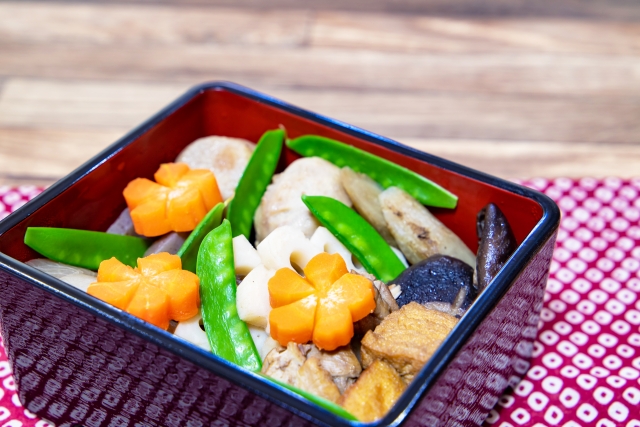
「おせち」も日本の正月には欠かせない話題となりますね。
We eat traditional dishes called “osechi” during the New Year holidays.
(私たちはお正月に「おせち」という伝統的な料理を食べます。)
It includes many kinds of Japanese traditional foods, and they are usually packed in three-tiered boxes.
(それにはたくさんの種類の日本の伝統的な食べ物が含まれ、よく3段の箱に詰められています。)
tiered : 段(層)になった
Each dish has a meaning, and we eat them to pray for good health, great harvest, longevity, and the prosperity of our descendants for the year.
(それぞれの料理に意味があり、その年の健康、豊作、長寿、子孫繁栄などを祈って食べます。)
great / rich harvest : 豊作
prosperity of descendants : 子孫繁栄
We prepare osechi dishes before New Year’s day in order to avoid being busy on the first three days of the New Year.
(お正月の三が日に忙しくなることを避けるために、新年の前におせち料理を準備します。)
5、お雑煮について
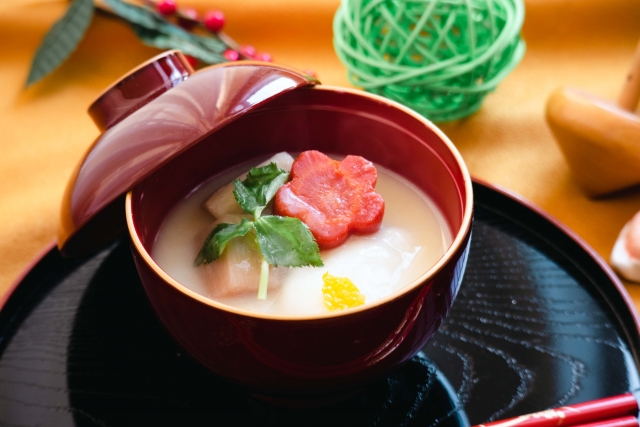
「お雑煮」もお正月に欠かせない一品ですね。
地域によってつくり方や材料が違うのも特徴でおもしろいです。
うまく伝えられるようにしておきましょう。
Japanese people have a soup called “Ozoni” for New Year’s day.
(日本人は新年に「お雑煮」と呼ばれるスープを食べます。)
Ozoni is a Japanese traditional New Year’s soup dish.
(お雑煮は日本の伝統的なお正月のスープ料理です。)
It is a bowl of soup made with vegetables and sticky rice cake.
(それは、野菜やお餅が入ったスープです。)
The ingredients differ depending on the region or family.
(材料は地域や家族によって異なります。)
In eastern Japan, they basically make soup with soy sauce base.
(東日本では、基本的に醤油ベースでスープをつくります。)
In the Kansai region, in particular Kyoto and Nara prefecture, they use mainly white miso for the soup.
(関西地域、特に京都と奈良では、主にスープには白味噌を使います。)
関西は英語で Kansai で通じますが、会話の相手が日本の地域にあまり詳しくない人であれば、“western Japan” と言うといいでしょう。
The same as Osechi, each ozoni ingredient has a special meaning, and it is eaten to wish for good health and long life and so on.
(おせちと同様に、お雑煮のそれぞれの食べ物に、特別な意味があり、健康や長寿などを願って食べられます。)
6、初詣について
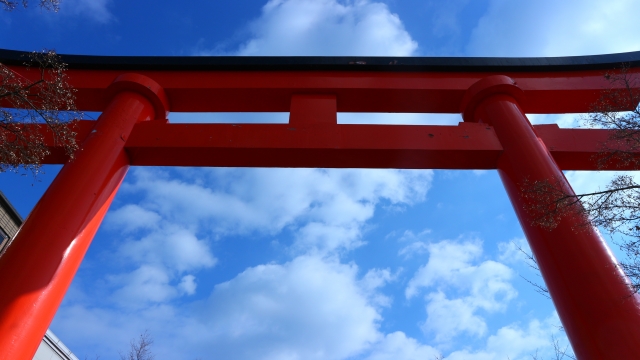
「初詣」に該当する英単語は特にないので、シンプルに伝えるといいでしょう。
例えば、”the shrine visit on the New Year” と言えます。
「参拝」「礼拝」の英語には、”worship” という言葉があります。
「崇拝する」の意味もあり、”to worship God” で「神を崇拝する」の意味です。
他に、”go to a shrine” や “visit a shrine” も「参拝する」の意味として使えます。
Many Japanese people visit a shrine during the New Year’s holiday.
(多くの日本人は正月中に神社へ訪れます。)
And then, we usually pray for good fortune and health during the year.
(そしてその年の幸運や健康を祈ります。)
We call it “Hatsu-moude” which means the first shrine visit on the new year.
(新年になって、年のはじめに訪れる参拝を「初詣」と呼んでいます。)
We enjoy drawing fortune slips at the shrine.
神社で「おみくじ」をひくのが人気です。
新年に占う「おみくじ」は、英語では “a fortune slip” もしくは ”a paper fortune” で伝わるでしょう。
“slip” は動詞で「滑る」の意味ですが、名詞で「紙切れ」の意味があります。
「おみくじをひく」の「ひく」は “draw” か “pull” で表せます。
7、寺と神社の違い
寺と神社の違いも英語で説明できるといいですね。
日本語でも説明するのは難しいかもしれません。でもよく聞かれる質問のひとつなので、覚えておくといいでしょう。
| 寺 | temple |
| 神社 | (Shinto) shrine |
違いは信仰の違いで、寺は仏教、神社は神道となります。
神社の漢字を思い出せば、混乱することはないですね。
神社のことを英語で、”Shinto shrine” と言うこともあります。
寺には仏像がまつられ、神社には神がまつられています。
A temple is a Buddhist building holding Buddhist statues, while on the other hand, a shrine is a building for the Shinto religion enshrining Shinto deities.
(寺は仏教のための場所で、仏像をまつっています。一方で、神社は神道のための場所で、神をまつっています)
deity / deities ( 複数形):神
大文字で始まる God は基本的にキリスト教やイスラム教の一神教の神のことを指します。日本のような多神教の場合、”a god” や “gods” で表します。
enshrine:祀る
Shinto is an indigenous religion of Japan, while Buddhism was founded in India and introduced to Japan through China and Korea.
(神道は日本固有の宗教で、仏教はインドに基づき、中国や韓国を渡って日本へ伝わりました。)
indigenous:固有の、原産の
be founded:設立される、基づく、基礎は…にある
be introduced:伝わる
最後に
いかがでしたでしょうか。
日本のお正月は1年で最も大事なイベントとなるので、しっかり説明できるようにしておきたいですね。
今回紹介した例文は、声に出して読む練習をすることをおすすめします。
